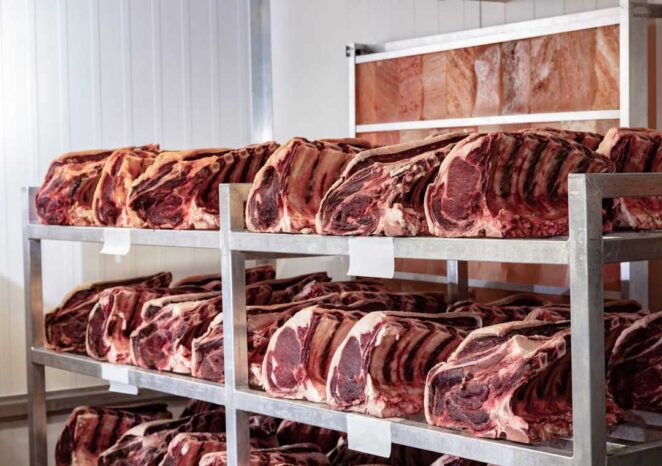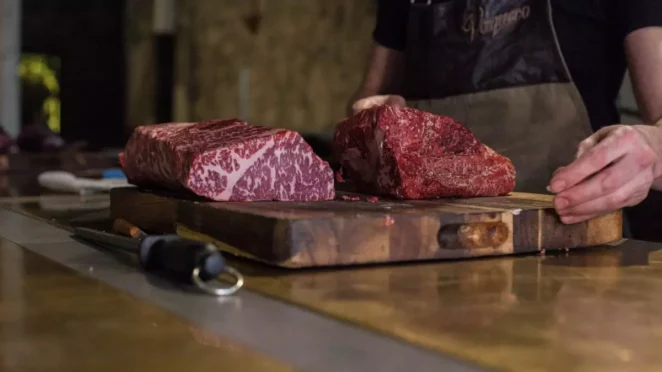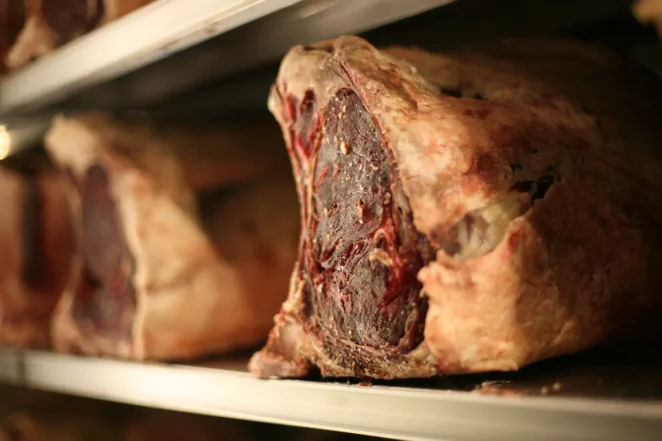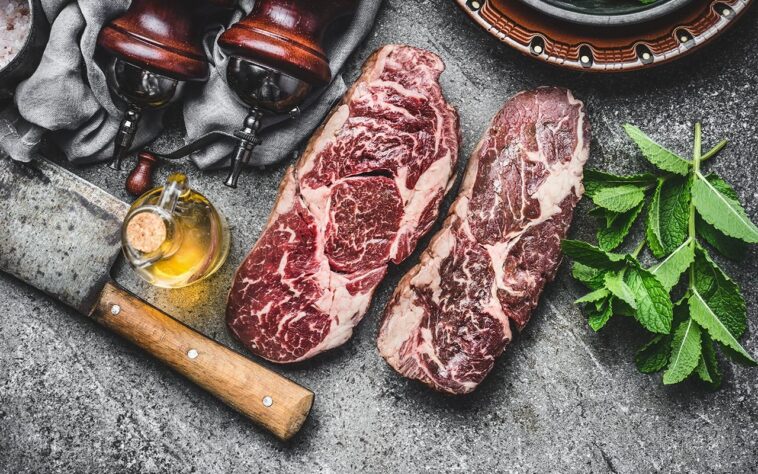Aged beef is one of the most valued meats in cooking due to the complex taste that dry aging gives to the meat. The process of controlled drying of the meat takes place with the help of dehydration when enzymes turn the most ordinary piece of veal into a real delicacy.
But what actually happens in that whole process? Why is this kind of meat one of the tastiest and most expensive? How does dry aged beef make all recipes better and the food much tastier than when it is prepared in the usual way?
It seems to be a process that achieves all those flavors that even top chefs strive to achieve.
Well, let’s see how it all plays out:
1. The Basics of Dry Aging
Dry aging is a traditional method of preserving veal. The piece of meat is placed in a refrigerator, with a strictly regulated temperature, while there is a constant flow of air with which the moisture is extracted from the meat. As a result, a perfectly preserved piece is obtained, ready to be further prepared and combined with various ingredients.
But how is this method different, and why is it better than wet aging?
Wet aging is the process in which the meat is vacuumed and left to stand in its own juices. So, when you open it, you practically have a fresh piece of meat that contains juices and is very juicy to prepare. Dry aging allows for a natural and gradual breakdown of muscle fibers and enzymes, resulting in unique flavor profiles.

2. What Actually Happens
Two factors are very important in dry aging ─ the loss of moisture and enzyme activity. As the meat dries, the enzymes create a concentration of natural flavors in the cut. That’s why the taste is more intense, and you don’t have to use a lot of spices during preparation. Moreover, enzymes present in the meat work to break down connective tissue, enhancing tenderness and contributing to overall flavor development.
Of course, dry-aged beef does not mean that the meat is completely dry, but that the flavors are concentrated and intense, and the meat is soft and easy to prepare quickly.
3. Time as a Key Factor
You may have wondered how long it takes for a piece of aged dry beef. Depending on your goal, the meat can be dried for several weeks, several months, or longer than a year. That is why there are different categories of dried meat. The length of aging is a delicate balance, as prolonged periods can result in excessive drying and an excessively intense taste.
Of course, you can’t do this yourself at home. On the contrary, it takes a lot of knowledge and dedication to get this process done right and to maintain the quality of the meat rather than causing spoilage.

4. How to Choose Meat for Dry Aging?
Not every cut is suitable for preparation with this method. It’s best to choose cuts with higher fat content, such as ribeye or strip loin. They are known for what is called marbling, which is great for bringing out the flavor and making the meat more tender.
Of course, the quality of the meat is important because if you use low-quality meat, you will not get a tasty end product. Maybe some of you don’t want to waste a perfect piece of meat with this method, but still, how you prepare it is your choice or decision.
Choose quality meat because the dry aging process is ideal for enhancing the best flavors but also for achieving an excellent consistency of the piece. Prime or high-quality cuts are often the best choices for this process.
5. The Art of Dry Aging
So far, from all of this content, you may have thought that you can do dry-aging yourself at home. But we have to disappoint you right away. First of all, it requires a great knowledge of how the meat is processed, how it is cut, and which parts need to be removed to achieve the desired effect.
Then, as we said, strictly controlled conditions are needed in which the temperature and humidity are at an optimal level. In this way, any risk of meat spoilage is avoided. Regular trimming of the dry-aged beef is necessary to remove any dried and hardened exterior, revealing the tender, flavorful meat underneath.
This whole process requires dedication, time, and patience, but also knowing how to do these things and achieve the ultimate culinary transformation. That’s why this way of preparing beef is so appreciated among many cuisines, as well as luxury and high-profile restaurants. And the taste? It’s out of this world! Those who’ve tried can confirm it.

6. Savoring the Result
This process that we have described can sometimes take longer than you expect. But therefore, the end result is meat that has incredible taste, softness, and aroma. When you prepare this kind of meat, even the cooking process itself is a gastronomic experience, because of the aroma.
When cooked, dry-aged beef exhibits a remarkable depth of taste, with notes of nuttiness, buttery richness, and a sublime umami experience. No matter what you pair it with, each bite offers a wonderful depth of flavors that combine to create a real treat for your taste buds. And it’s really not modest to say that all of this is a direct consequence of professional dry aging, thanks to which eating veal has been turned into an art.
Conclusion
Dry aging is a real art in gastronomy and cooking. In this way, the taste and the most important characteristics of the meat are preserved, resulting in a delicacy that no other cut has.
So, embark on this gastronomic adventure, and let your taste buds savor the richness and complexity of the art of dry aging. And of course, if you don’t know yourself, let someone else prepare it all for you.
You only need to take your time and enjoy the result, the rich taste and extraordinary aroma.



